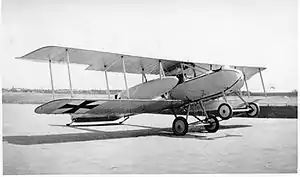AGO C.I
The AGO C.I was a First World War German pusher reconnaissance biplane that used a pod-and-boom configuration.
| C.I | |
|---|---|
 | |
| Forward oblique view of the AGO C.I | |
| Role | Reconnaissance |
| Manufacturer | AGO Flugzeugwerke |
| Designer | August Häfeli |
| Introduction | June 1915 |
| Primary user | Germany |
| Number built | 64 |
| Variants | AGO C.II |
Development
The crew and pusher engine shared a central nacelle, and the twin booms carried the tail and the four-wheeled landing gear. The observer sat at the nose and was armed with a machine-gun.[1]
A single example was fitted with floats for coastal patrol duties for the Imperial German Navy (designation C.I-W).
Specifications

AGO C.I
General characteristics
- Crew: two, pilot and observer
- Length: 9.0 m (29 ft 6 in)
- Wingspan: 15.0 m (49 ft 2 in)
- Wing area: 41.5 m2 (447 sq ft)
- Powerplant: 1 × Mercedes D.III , 117 kW (158 hp)
Performance
- Maximum speed: 140 km/h (90 mph, 78 kn)
- Range: 480 km (300 mi, 260 nmi)
- Service ceiling: 4,800 m (16,000 ft)
Armament
See also
Aircraft of comparable role, configuration, and era
References
Wikimedia Commons has media related to AGO C.I.
Citations
- van Wyngarden, G (2006). Early German Aces of World War I, Osprey Publishing Ltd. ISBN 1-84176-997-5
Bibliography
- Grosz, Peter M. (1999). Ago C.I. Windsock Datafile No. 75. Albatros Productions. ISBN 978-1902207162.
- Taylor, Michael J. H. (1989). Jane's Encyclopedia of Aviation. London: Studio Editions. p. 39.
- "Das Virtuelle Luftfahrtmuseum".
This article is issued from Wikipedia. The text is licensed under Creative Commons - Attribution - Sharealike. Additional terms may apply for the media files.